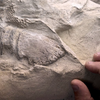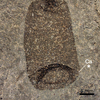The Ancient History of Man's Best Friend

Canis lupus familiaris
The relationship between dogs and humans stretches across thousands of years, the early history of our two species defined by their relationship with each other. Dogs benefited from the excess food nomadic tribes produced, while their superior sense of smell (200 million olfactory neurons to humans’ five million) and hearing (four times greater than ours) greatly aided in hunting. That said, the relationship between our species was not strictly utilitarian; even in the Paleolithic, humans kept dogs as pets, as evinced by the Bonn-Oberkassel dog, buried alongside two humans 14,200 years ago.
Discovered in 1914 near Bonn, Germany, the Bonn-Oberkassel dog was buried with a man around 40 years old and a 25-year-old woman, all three bodies painted in decorative red ochre, a common ritual practice. The dog was around 27 weeks old when it died from a serious periodontal infection. Importantly, the high mortality rate of such a gum infection means that the dog only survived because of intense care from its owners, suggesting an emotional connection far beyond a purely transactional relationship. The ailing dog was likely killed when its owners died, allowing the three to be buried together.
 The Bonn-Oberkassel dog's jaw
The Bonn-Oberkassel dog's jaw
The Bonn-Oberkassel remains were thought to be the oldest buried dog in the archeological record until a 2018 reexamination of the grave found that one tooth belonged to an older dog. This tooth appears to have been a grave good buried alongside the humans, again demonstrating an emotional tie to the animals. The limited remains of this older dog makes further study difficult, but coupled with Bonn-Oberkassel, a picture forms of early human-dog relationships. Our species first came together for pure survival reasons, but the pet relationship came soon after.
Bonn-Oberkassel is the earliest confirmed dog burial, but it is far from unique. The Koster Site in Illinois includes a number of buried dogs dated to 10,000 years ago, while the Ashkelon Dog Cemetery in Palestine houses thousands of specimens, possibly venerated as a sacred animal. Across the archeological record, man’s best friend appears again and again, an early sign of human emotional development during the Paleolithic.
Featured Product
Joe Frazier Boxing Glove
Cool Things!

Is “Paul is Dead” Dead?: Unpacking One Of Pop Culture’s Most Enduring Conspiracy Theories

Scientists Discover Hooves and Skin in Preserved Dinosaur "Mummies!"
A dinosaur discovery just in time for Halloween! In a new analysis of a group of fossils from Wyoming, Scientists have determined this group of fossils are dinosaur “mummies,” with preserved skin and even hooves.

Scientists Record a Bat Catching Birds Mid-Flight!
Bats, birds, screeches, oh my! In a reverse-Hitchcock twist, a new study reveals that a species of European bat catches and eats birds mid-flight.
Specimen Deep Dives

The House that Ruth Built: The Story of the Old Yankee Stadium

The Queen of the Skies: the Story of the Boeing 747

Old Ironsides: The USS Constitution and the Start of the U.S. Navy
Long Form Articles

The Artist Behind the Macintosh: Susan Kare and Apple Computers
While the two Steves, Jobs and Wozniak, are the most well known faces behind Apple computers, equally important to the products and culture of the company were those who crafted the experience of using their computers through design. The most notable of these visual architects was Susan Kare, a designer responsible for “humanizing” Macintosh computers.

Can I Lick It? Yes You Can!
Have you ever been unable to tell if a fossil was really a fossil, but you were too embarrassed to admit it? Have you ever wanted to lick a fossil just because, but you didn’t want to risk judgment from your peers? Well, good news! You can kill two birds with one stone! Licking a fossil can actually help you determine if it’s the real deal or just another rock.

Is It Legal To Own a Meteorite: How to Start Your Outer Space Collection!
Meteorites are some of the rarest geological specimens to be found on Earth. Of course, since these stones are not of our world, purchasing them can sometimes be a confusing process. Is it legal to own a meteorite? In short, yes! Read on for help starting your cosmic collection!


















